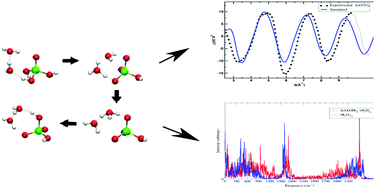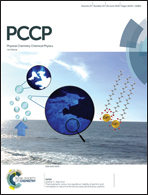On the aqueous solvation of AsO(OH)3vs. As(OH)3. Born–Oppenheimer molecular dynamics density functional theory cluster studies†
Abstract
While arsenous acid, As(OH)3, has been the subject of a plethora of studies due to its worldwide ubiquity and its toxicity, pentavalent As in the form of arsenic acid, AsO(OH)3, has recently been found in rivers in central Mexico as the most abundant naturally occurring arsenic species. To better understand the solvation patterns of both toxic acids at the molecular level, we report the results of Born–Oppenheimer molecular dynamics simulations on the aqueous solvation of the AsO(OH)3 and As(OH)3 molecules at room temperature using the cluster microsolvation approach including 30 water molecules at the B3LYP/6-31G** level of theory. We found that the average per-molecule water binding energy is ca. 1 kcal mol−1 larger for the As(V) species as compared to the As(III) one. To account for the asymmetry of both molecules, the hydration patterns were studied separately for a “lower” hemisphere, defined by the initially protonated oxygens, and for the opposite “upper” hemisphere. Similar lower hydration patterns were found for both As(III) and As(V), with the same coordination number CN = 7. The upper pattern for As(III) was found to be of a hydrophobic type, whereas that for As(V) showed the fourth oxygen to be hydrogen-bonded to the water network, yielding CN = 3.7; moreover, a proton “hopped” from the lower to the upper side, through the Grotthuss mechanism. Theoretical EXAFS spectra were obtained that showed good agreement with experimental data for As(III) and As(V) in liquid water, albeit with somewhat longer As–O distances due to the level of theory employed. Proton transfer processes were also addressed; we found that the singly deprotonated H2AsO3− species largely dominated (99% of the simulation) for the As(III) case, and that the deprotonated H2AsO4− and HAsO42− species were almost equally present (45% and 55%, respectively) for the As(V) case, which is in line with the experimental data pKa1 = 2.24 and pKa2 = 6.96. Through vibrational analysis the features of the Eigen and Zundel ions were found in the spectra of the microsolvated As(III) and As(V) species, in good agreement with experimental data in aqueous solutions.



 Please wait while we load your content...
Please wait while we load your content...